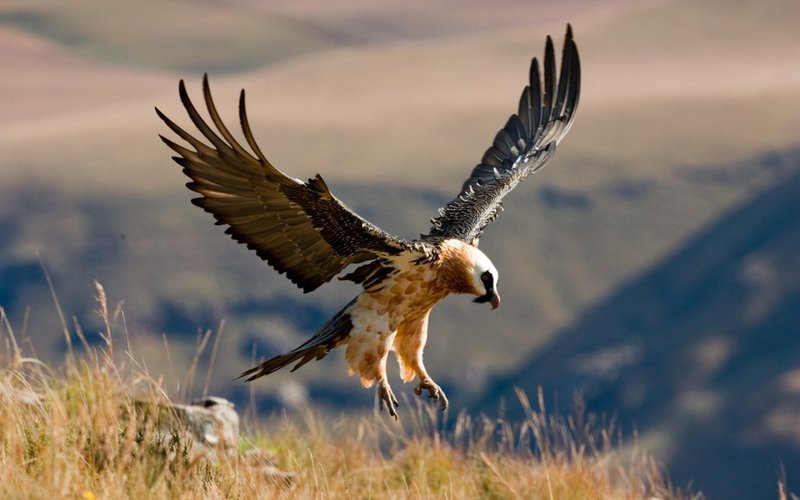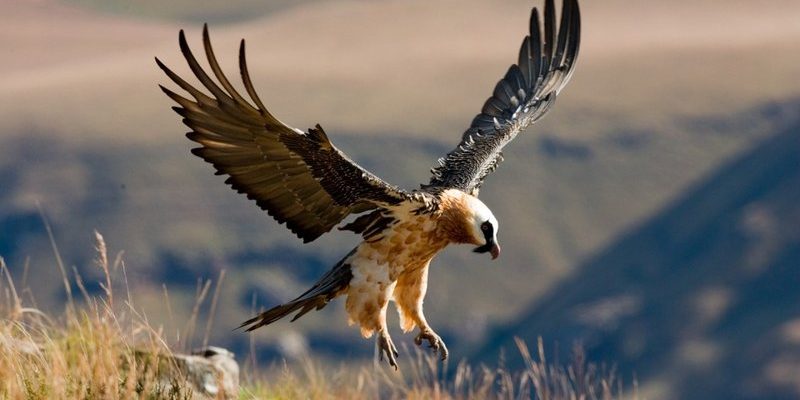
Flying Techniques: Mastering the Art of Gliding
Bearded vultures are incredible fliers, making the most of the mountain air currents to travel impressive distances. Their long, broad wings allow them to glide effortlessly, conserving energy while they soar. Unlike many birds that flap their wings to gain altitude, the bearded vulture takes advantage of thermals—rising columns of warm air. As these thermals lift them higher, they can stay airborne for hours without flapping a feather.
But here’s the thing: this gliding isn’t just about showing off. It’s a practical skill. By flying high, they can spot potential food sources from a distance. This ability to survey vast areas is critical in their search for bones, which they can then swoop down to collect. Moreover, their sharp vision can detect movement far below, allowing them to detect other animal activity that might lead to a meal.
Additionally, these vultures can reach altitudes of over 20,000 feet. Imagine standing on top of a high mountain and watching them effortlessly navigate the skies above you. Their wings are not only designed for soaring but also for maneuvering through rugged terrains, allowing them to navigate cliffs and crags where other scavengers might struggle.
The Role of Wind in Their Flight
Wind is a crucial factor in how bearded vultures fly. They often take advantage of strong winds to lift themselves higher. By catching upward drafts, they can achieve great heights without exerting too much energy. This strategy is similar to how a kite utilizes the wind to stay afloat. As they soar, they can scope out the landscape below, looking for the telltale signs of carcasses or bone piles.
When the wind conditions are right, you might see bearded vultures making graceful turns and loops, showcasing their agility. This display isn’t just for fun; it serves a purpose. By practicing these maneuvers, they become more efficient at hunting, ultimately leading to a higher chance of survival.
Hunting Techniques: The Bone Specialists
Now let’s talk about how bearded vultures actually hunt. Unlike many scavengers, they don’t just wait for an animal to die. Instead, they actively seek out carcasses, focusing on the bones left behind by larger predators. Think of them as the clean-up crew of the animal kingdom, efficiently recycling nutrients back into the ecosystem.
One of their signature hunting techniques involves dropping bones from a great height. Once they’ve located a bone, they carry it high into the sky, often over rocky surfaces. They then release the bone, allowing it to crash and shatter upon impact. This clever strategy breaks the bone into manageable pieces, making it easier for them to access the nutrient-rich marrow inside. Imagine a chef effortlessly chopping vegetables—this is what the bearded vulture does with bones.
Additionally, they have incredibly strong beaks designed specifically for this task. Their beaks can crush even the toughest bones, allowing them to extract every bit of nutrition. In fact, about 70% of a bearded vulture’s diet consists of bones, showcasing their unique adaptation to their environment.
Social Hunting and Learning
Interestingly, bearded vultures are social hunters. They often hunt in pairs or small groups, taking advantage of each other’s skills and knowledge. This collaboration is not only effective but also demonstrates their intelligence. Younger vultures learn from older, more experienced ones, picking up tips on where to find food and the best techniques for breaking bones.
You might find it surprising, but these birds also engage in what can only be described as playful behavior. They may play with bones before eating them, honing their skills while having fun. This playful side is an essential part of their learning process. Much like humans learning new techniques in the kitchen, young vultures improve their hunting skills through practice.
The Importance of Bearded Vultures in Ecosystems
Bearded vultures play a vital role in their ecosystems. By consuming bones, they help recycle nutrients back into the soil, fostering healthy plant growth. This natural service is essential for the environment, as it ensures that nutrients are available for other species.
Moreover, by scavenging on remains that other animals leave behind, they minimize the risk of disease spreading within the ecosystem. Carcasses that aren’t cleaned up can attract other scavengers, leading to potential health hazards. You can think of them as nature’s garbage collectors, keeping the environment healthy and clean.
However, due to habitat loss and other human activities, bearded vultures have faced significant threats. Conservation efforts are crucial for their survival, and understanding their unique behaviors is the first step in ensuring they continue to thrive in the wild.
Conservation and Its Challenges
Conservation efforts for bearded vultures involve protecting their habitats and ensuring that the food sources they depend on remain plentiful. Many organizations are working tirelessly to educate the public about these majestic birds and the importance of maintaining healthy ecosystems.
However, challenges remain. Pollution, hunting, and habitat destruction all threaten their survival. It’s essential for communities to come together to protect their natural habitats. Just like we depend on clean air and water, so do these incredible creatures.
The bearded vulture is a remarkable bird, showcasing unique flying and hunting techniques that set it apart from other species. Their mastery of gliding and their innovative bone-cracking methods make them a crucial part of their ecosystem, serving as nature’s recyclers. By understanding and appreciating these fascinating creatures, we can take meaningful steps toward protecting them.
So next time you hear about vultures or see a majestic bird soaring in the sky, take a moment to consider the incredible adaptations that allow them to thrive. Let’s celebrate the legacy of the bearded vulture and work together to ensure their future. Just like any great chef, they deserve a place in our world—where they can continue to do their unique work while soaring high above the mountains.

